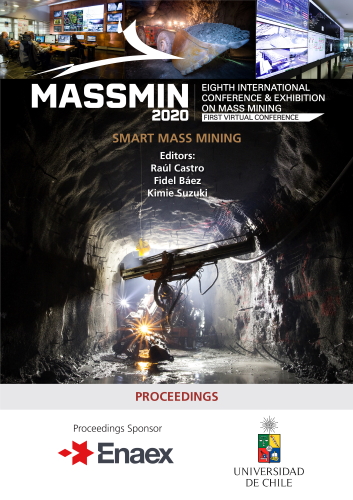Physical modelling of cave breakthrough into an overlying cave

|
Authors: Cumming-Potvin, D; Wesseloo, J; Jacobsz, SW; Potvin, Y; Mooney, A |
This paper is hosted with the kind permission of Lulea University of Technology, International Conference & Exhibition on Mass Mining, 2024.
DOI https://doi.org/10.36487/ACG_repo/2063_32
Cite As:
Cumming-Potvin, D, Wesseloo, J, Jacobsz, SW, Potvin, Y & Mooney, A 2020, 'Physical modelling of cave breakthrough into an overlying cave', in R Castro, F Báez & K Suzuki (eds), MassMin 2020: Proceedings of the Eighth International Conference & Exhibition on Mass Mining, University of Chile, Santiago, pp. 478-488, https://doi.org/10.36487/ACG_repo/2063_32
Abstract:
Access to the caving column in caving mines is limited and, as a result, the amount of data that can be collected (in particular observational data) is very limited. These limitations have resulted in a situation where the mechanisms of cave propagation and breakthrough are poorly understood. Cave breakthrough is of particular importance, as it is a crucial, high-risk stage of cave development. This is exacerbated by the increasingly high cave columns being mined in recent years. Breakthrough of a cave into an existing, overlying cave adds additional challenges as the connection at depth creates high induced stresses and large scale stress redistribution, sometimes resulting in large seismic events. Since visual access to the cave column is possible with physical modelling, it can deliver important insight into the caving mechanisms evolved. This is even more critical for situations of cave breakthrough into existing caves, as they are relatively rare in industry – limiting the ability to study them. In order to better understand these cave breakthrough events, a research project sponsored by Oz Minerals was created to model such situations in a geotechnical centrifuge. Four tests have been completed to date, the preliminary results of which show a potential mechanism of cave connection which has been previously unrecognised. This involves failure of the corners around the existing overlying cave when the cave back of the propagating cave below has only reached one-half to three-quarters of the vertical height of the cave column. The analysis is only in the early stages and further work is necessary to confirm the validity of the observed mechanism and rule out the possibility that it is an artefact resulting from the test methodology. Further research will focus on more detailed analysis of the results and further tests to better understand the observations from the first four tests.
References:
Cuello, D & Newcombe, G 2018, 'Key geotechnical knowledge and practical mine planning guidelines in deep, high-stress, hard rock conditions for block and panel cave mining', in Y Potvin & J Jakubec (eds), Fourth International Symposium on Block and Sublevel Caving, 2018, Vancouver, Australian Centre for Geomechanics, pp. 17-36.
Cumming-Potvin, D 2018, 'An Extended Conceptual Model of Caving Mechanics'. PhD, The University of Western Australia.
Cumming-Potvin, D, Wesseloo, J, Jacobsz, SW & Kearsley, EP 2018, 'A re-evaluation of the conceptual model of caving mechanics', in Y Potvin & J Jakubec (eds), Fourth International Symposium on Block and Sublevel Caving, 2018, Vancouver, Australian Centre for Geomechanics, pp. 179-190.
Cumming-Potvin, D, Wesseloo, J, Jacobsz, SW & Kearsley, EP 2016a, 'Fracture Banding in Caving Mines', The Journal of the Southern African Institute of Mining and Metallurgy, vol. 118, no. 8, pp. 753-761.
Cumming-Potvin, D, Wesseloo, J, Jacobsz, SW & Kearsley, EP 2016b, 'Results from Physical Models of Block Caving', MassMin2016, 9 - 11 May 2016 2016b, Sydney, Australia, The AusIMM, pp. 329-340.
Duplancic, P & Brady, BH 1999, 'Characterisation of Caving Mechanisms By Analysis of Seismicity And Rock Stress', 9th ISRM Congress, 25-28 August 1999 1999, Paris, France, International Society for Rock Mechanics, pp. 1049-1053.
Glazer, S 2018, Mine Seismology: Seismic Response to the Caving Process, Springer International.
Glazer, S & Hepworth, N 2006, 'Crown pillar failure mechanism – case study based on seismic data from Palabora Mine', Mining Technology, vol. 115, no. 2, pp. 76-84.
Glazer, S & Hepworth, N 2005, 'Seismicity Induced by Cave Mining, Palabora Experience', in Y Potvin & M Hudyma (eds), 6th International Symposium on Rockbursts and Seismicity in Mines, 2005, Perth, Australian Centre for Geomechanics, pp. 275-280.
Hoek, E 1965, 'The Design of a Centrifuge for the Simulation of Gravitational Force Fields in Mine Models', Journal of the South African Institute of Mining and Metallurgy, vol. 65, no. 9, pp. 455-487.
Hudyma, M, Potvin, Y & Allison, D 2007a, 'Seismic monitoring of the Northparkes lift 2 block cave—Part 1 undercutting', 1st International Symposium on Block and Sublevel Caving, 2007a, Cape Town, SAIMM, pp. 303-334.
Hudyma, M, Potvin, Y & Allison, D 2007b, 'Seismic monitoring of the Northparkes lift 2 block cave—Part 2 production caving', 1st International Symposium on Block and Sublevel Caving, 2007b, Cape Town, SAIMM, pp. 335-354.
Jacobsz, SW, Kearsley, EP & Kock, JHL 2014, 'The geotechnical centrifuge facility at the University of Pretoria', in C Gaudin & DJ White (eds), 8th International Conference on Physical Modelling in Geotechnics, 2014, Perth, Australia, Taylor & Francis Group, pp. 169-174.
Potvin, Y & Hudyma, M 2008, 'Interpreting caving mechanisms using microseismic monitoring data', in H Schunnesson & E Nordlund (eds), Proceedings of MassMin 2008, Luleå, Sweden, Luleå University of Technology, pp. 971-982.
Srikant, A, Brannon, C, Flint, DC & Casten, T 2007, 'Geotechnical characterization and design for the transition from the Grasberg open pit to the Grasberg block cave mine', 1st Canada-US Rock Mechanics Symposium, 2007, Vancouver, American Rock Mechanics Association.
Stanier, SA, Blaber, J, Take, WA & White, D 2016, 'Improved image-based deformation measurement for geotechnical applications', Canadian Geotechnical Journal, vol. 53, no. 5, pp. 727-739.
Wesseloo, J, Cumming-Potvin, D, Potvin, Y, Jacobsz, SW, Bosman, T & Schoeman, N 2020, 'Towards data rich verification and validation of numerical modelling predictions to cave mechanics problems', Proceedings of MassMin 2020, Santiago, Chile.
© Copyright 2026, Australian Centre for Geomechanics (ACG), The University of Western Australia. All rights reserved.
View copyright/legal information
Please direct any queries or error reports to repository-acg@uwa.edu.au
View copyright/legal information
Please direct any queries or error reports to repository-acg@uwa.edu.au
